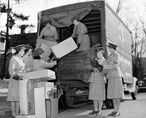
The Canadian Red Cross Society (CRCS), like most national Red Cross societies, had grown so rapidly, and accomplished so much, during the First World War, that its leaders were reluctant to see it disappear again, after the end of the war. They felt it could accomplish great things in peacetime as well. With the support of the international community, which established a new League of Red Cross Societies to coordinate national Red Cross society work in peacetime, the CRCS sought, and obtained, an expanded mandate from the federal government: as of 1919 it was empowered “In time of peace or war to carry on and assist in work for the improvement of health, the prevention of disease and the mitigation of suffering throughout the world.” The Society’s first peacetime public health work actually predated this amendment: local and provincial branches contributed leftover wartime medical supplies and offered a variety of other assistance as the worldwide “Spanish Flu” epidemic hit Canada during the winter of 1918-1919.
The Society’s new, broader mandate led it to become involved in a wide array of peacetime public health and welfare work during the 1920s and 1930s. Like the entire public health movement of the period, the CRCS often focused its work on the health of mothers and children. Among other things, the Canadian Red Cross established outpost hospitals and nursing stations (usually staffed by a single nurse) in remote and new settlement areas of the country; sent well-baby clinics and mobile dental clinics to remote areas; established public health nursing training programs at several Canadian universities; promoted the Junior Red Cross as a way to teach schoolchildren the principles of good health, service, and citizenship; provided support and respite for immigrant mothers and children arriving in Canada, through Seaport Nurseries; trained ordinary Canadians in the techniques of First Aid and Home Nursing; offered help to sick wives and mothers through Visiting Housekeepers; provided relief in response to natural disasters; and offered relief and sheltered employment to needy veterans and their families. The Great Depression (1929-1939) both dramatically increased the numbers of suffering Canadians, and decreased the CRC’s ability to help (through decreased funds) – some provincial divisions in the West were brought to the brink of bankruptcy. However, the Society maintained its core public health programs, and attempted to help where it could. (For instance, the Red Cross acted as a distribution agent for government clothing relief in Saskatchewan.)
In 1927 the Canadian Red Cross Society was officially recognized by the International Committee of the Red Cross as an independent Red Cross Society, rather than a branch of the British Red Cross. A 1926 British Empire Conference had changed the status of Britain’s Dominions, making Canada an autonomous entity rather than a colony. This meant that under international Red Cross rules Canada (likewise Australia, New Zealand, and South Africa) was now allowed to have its own independent Red Cross.
Sources:
CRCS. Annual Reports. 1919-1939
Glassford, Sarah Carlene. “Marching As to War: The Canadian Red Cross Society, 1885-1939.” PhD dissertation, York University, 2007.